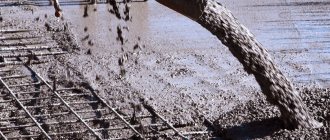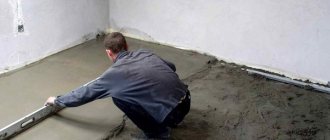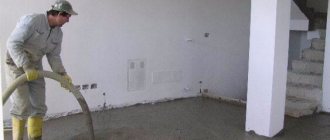The temperature of the concrete is a very important point. The temperature of the concrete mixture should be in the range from +5⁰С to +30⁰С. At a temperature of +5⁰С, the hardening process of concrete slows down significantly. The first phase, setting, and the subsequent increase in strength slow down. If the average daily temperature of concrete is +5⁰С, then it takes twice as long for the concrete to gain the same strength as at +20⁰С.
At temperatures close to 0⁰C, concrete practically stops gaining strength, and if fresh concrete freezes, irreversible structural damage can occur. The hydration reaction takes a long time, the water does not immediately react with the cement, and when freezing, unbound water forms pores and capillaries in the concrete. The water frozen in these capillaries increases its volume to 9% and destroys the concrete, breaking the bonds of the cement stone with the aggregate grains with crystalline ice. The result will be a strong decrease in the strength of concrete after thawing; this concrete will never regain its original strength.
At what temperature should concrete be poured?
One of the important criteria for concrete to gain the required strength (compressive strength) is its hardening temperature.
Failure to comply with the temperature regime at a construction site can result in a significant increase in the delivery time of the project or, much worse, in defects in the future design. That is why, even at the planning stage of monolithic work, it is necessary to clearly understand at what temperature the concrete is poured.
The reference conditions under which concrete gains maximum (grade) strength in 28 days is considered to be +20°C. This indicator is designated R28 and is taken equal to one under these conditions.
In other situations, strength takes on a fractional value. So 0.3 R28 means 30% of the design strength.
Strength of concrete depending on temperature and time
Concrete hardening time, daysRelative strength of concrete at hardening temperature
| -3°C | 0°C | 5°C | 10°C | 20°C | 30°C | |
| 1 | 0,03 | 0,05 | 0,12 | 0,21 | 0,34 | 0,37 |
| 2 | 0,06 | 0,12 | 0,19 | 0,32 | 0,5 | 0,52 |
| 3 | 0,08 | 0,18 | 0,23 | 0,38 | 0,6 | 0,6 |
| 7 | 0,15 | 0,28 | 0,31 | 0,51 | 0,78 | 0,75 |
| 14 | 0,2 | 0,3 | 0,37 | 0,6 | 0,9 | 0,85 |
| 28 | 0,25 | 0,36 | 0,43 | 0,7 | 1,0 | 0,93 |
| 56 | 0,3 | 0,4 | 0,49 | 0,79 | 1,08 | 1,0 |
The data in the table are given for laboratory conditions and brands of cements with a normal hardening rate. In real conditions, the temperature varies over significant ranges, and the solution may have different characteristics. Therefore, it is recommended to slightly increase the holding time.
Pouring concrete at low and high temperatures
The main advice that can be given to people who build something with their own hands, without resorting to professional help and technology, is to pour concrete in the summer at temperatures above 10°C (in extreme cases, above 5°C). Then the concrete will harden to the required extent in a fairly short time.
If the temperature during curing can drop below 5°C, then you should think about technologies for heating the concrete or preserving the heat it generates. This is especially true in the first days when setting occurs. If at this time the water in the solution crystallizes, then the ice will simply break the formed bonds between the cement and the filler and the final product will turn out to be extremely fragile.
On the other hand, at temperatures above 30°C, the problem of excessive evaporation of moisture from the concrete body arises, which also negatively affects its quality. In this case, the poured concrete must be covered with a protective film and its surface must be periodically watered.
To measure temperature, you can use a non-contact thermometer (pyrometer), for example, like the one in the video:
Concrete demoulding can be carried out when the strength reaches around 50%, that is, on the third day at an air temperature of 20°C. When it reaches 60-70%, it is allowed to partially load the structure.
Advantages of a winter foundation
Constant changes in climatic conditions have led to the fact that “winter” construction conditions can occur even in September. This is due to the fact that sudden frosts and subsequent thaws make adjustments to the concrete pouring technology used by specialists. It is worth noting that there may not be snow, but in the northern regions of the country, where there are very few warm days, the average annual temperature does not exceed +5 ˚ C. That is why innovative foundation construction technologies have been developed, which are designed to extend the construction season.
Now you can pour high-quality concrete even at a temperature of -25˚ C. This significantly speeds up the construction of new buildings, since with the arrival of the first spring days you can safely begin building walls. If the house is built of wood, then its construction can continue - regardless of the temperature.
Are there minimum and maximum restrictions for carrying out work?
Sometimes circumstances are such that work must be carried out in hot summers or cold winters. There are temperature indicators that cannot be exceeded.
The minimum concrete hardening temperature at which the solution can be poured without adding additives and additional heating is +5°C.
The minimum temperature at which concrete is poured without additives is -3°C (in this case, the temperature of the solution must be maintained at +10°C for at least three days).
Various additives and methods of heating mortar or reinforcement make it possible to pour concrete at sub-zero temperatures.
Maximum temperature for working with concrete: +25°C. In hotter weather, work is carried out much faster, since the concrete sets in less time. The poured surface is additionally moistened every 2-3 hours.
Why doesn't cement harden?
The water that is part of the solution, at subzero temperatures, crystallizes and freezes. At the same time, ice crystals destroy the structure of the cement mass, it cracks. is torn. In the language of specialists, the hydration of cement stops. The result is low concrete strength, high porosity, loss of quality and integrity.
If during the day the expected air temperature is below – 5 degrees, the solidification of the solution will completely stop.
Time and money will be lost.
How to pour concrete in winter at low temperatures
Sometimes construction work is carried out in winter. For example, when constructing a building on loose soils. Pouring concrete in winter is cheaper due to lower prices for work and materials. The disadvantage of working in cold weather is the long drying period. In addition to adding additives, there are methods of physically heating the mixture or structure.
Thermos method
This method is used for massive structures. It does not require additional heating, but the temperature of the laid mixture should be more than +10C. The essence of this method is that the laid mixture, while cooling, has time to gain critical strength. The chemical reaction of concrete hardening is exothermic, i.e. heat is released. Therefore, the concrete mixture heats itself. In the absence of heat loss, concrete can heat up to a temperature of more than 70C. If the formwork and open surfaces are protected with heat-insulating material, thus reducing the heat loss of hardening concrete, the water will not freeze and the concrete structure will gain strength.
To implement the thermos method, no additional equipment is required, so it is economical and simple.
Electric heating of concrete mixture
This method allows the mixture to be heated evenly, while its strength increases and its service life increases.
The method is based on the ability of cement to conduct electricity. The electrodes are mounted inside the solution and on the surface, and voltage is supplied from the transformer. The parameters depend on the brand of cement, air temperature, volume and shape of the structure.
Types of electrodes for heating:
- Stripes. Used to heat horizontal structures. They are metal strips up to 5 cm wide.
- Rod. Sections of reinforcement with a diameter of up to 12 mm are installed in rows. The distance between the rods is determined in practice.
- Strings. Used for vertical structures, they are reinforcement with a diameter of up to 15 mm and a length of up to 3 m.
The electrodes are placed in the poured solution according to the following scheme: no closer than 3 cm to the formwork, no closer than 10 cm to the technological seam, the distance between the electrode rods and the frame reinforcement rods is 5-15 cm, the minimum distance between the working elements is 20 cm.
A prerequisite for electric heating of the mixture is additional thermal insulation.
The electrodes are connected to a generator that supplies alternating current. Direct current cannot be used during heating, as it provokes electrolysis and water molecules are destroyed, and cement hydration does not occur.
It is not recommended to use a welding machine for heating, as it can quickly fail.
The electric heating method has a number of disadvantages:
- High costs for consumables (electrodes remain in the monolith).
- High energy costs (about 1000 kV per 3-5 m3 of solution).
- The need for additional calculations.
Steam heating of concrete
Heating concrete with steam is very effective and is recommended for thin-walled structures. On the inside of the formwork, channels are created through which steam is passed. You can make double formwork and let steam pass between its walls. You can also lay pipes inside concrete and pass steam through them. Concrete is heated in this way to 50 - 80C. This temperature and favorable humidity accelerates the hardening of concrete several times. For example, in two days, with this method, concrete gains the same strength as during a week of hardening under normal conditions.
But this method has a significant drawback. It requires significant costs to organize it.
Ways to pour concrete without heating
The simplest solution to insure against damage to concrete poured in winter is to choose dry cement of a higher grade. You can also avoid negative consequences by adding more of the main component to the solution.
To prepare concrete that will be poured in the cold season, it is better to use cement grade M-400 or M-500
Another way to solve the problem is to make liquid concrete from more than just conventional components. With the help of various additives and plasticizers, special properties can be imparted to cement. For example, they can turn concrete into a compound that hardens much faster than it should. These additives are usually introduced into water, and then into cement.
Table: additives to accelerate concrete hardening
| Additive | Description |
| Potassium carbonate | A white crystalline powder that makes the structure of concrete coarsely porous. Recommended amount of additive - up to 5% by weight of cement |
| Calcium chloride | White crystalline powder or aqueous solution. When exposed to air for a long time, the powdery substance spreads |
| Calcium nitrate | Colorless crystals that dissolve well in liquids |
| Sodium sulfate | Colorless crystals that decompose when heated, releasing oxygen |
| Sodium aluminate | Water solution. Dosage - 3% by weight of cement |
| Quicklime (calcium oxide) | Crystalline substance. Dosage - 2% by weight of cement. The product is aggressive towards steel fittings |
Conclusion
Concreting at minimum temperatures has a number of features and requires a special approach to the work. The most important thing is to prevent a cycle of freezing and thawing of the solution. But, at the same time, if you perform the operation correctly, you will end up with a more durable material than when pouring under normal conditions (see also the article “Aerated concrete partitions - the main nuances of construction”).
From the video in this article you can get some additional information on this topic.
Special antifreeze additives for the solution
To increase frost resistance, special chemical components are used. They make it possible to carry out work down to a temperature of -25°C.
Additives – increase hydration in frost conditions. They accelerate setting and hardening in combination with additional heating of concrete.
Antifreezes are compounds that increase the adhesion properties of a solution under any operating conditions. Additives are divided according to the main active ingredient included in the composition:
- Sodium formate. Increases the accumulation of salts in the monolith, used only in conjunction with plasticizers.
- Sodium chloride. Provokes corrosion of reinforcement and prevents rapid thickening of the solution. Suitable for Portland cement based mixtures.
- Sodium nitrite. Not used for alumina mixtures. Working with the solution becomes possible down to -15°C.
- Calcium carbonate (potash). Increases the operating temperature range to -30°.
Plasticizers - increase the density of the mixture, reducing the cost of cement and water. The working time for concrete with these additives is much longer, which allows you to take your time when laying.
Hardening accelerator - reduces working time, increases the strength of finished monoliths, but reduces the plasticity of concrete.
Complex additives - combine several ways to improve frost-resistant qualities.
The nuances of using additives:
- The operating conditions of the concrete structure are taken into account. For example, if the monolith will be exposed to intense gas, the concrete solution should not contain additives obtained from the reaction of calcium and hydrochloric acid.
- It is not recommended to mix additives on your own to improve various properties of the solution. The chemical elements included in the composition can negatively interact with each other. It is better to use ready-made complex additives.
- The presence of outlet and insert elements implies the use of antifreeze. It is added to the solution at the mixing stage.
Concrete work in winter - implementation features
It is difficult to call the winter months a favorable period for concreting monolithic structures, pouring foundations and forming bored supports. This is due to the crystallization of water. It complicates the hydration process, which results in the formation of strong bonds at the molecular level. When water expands as a result of crystallization, porosity increases, strength characteristics decrease, and cracking of the mass occurs.
In order for winter concrete to be strong, it is necessary to create conditions or additives for its ripening
After concreting, the following processes occur:
- grasping. The duration of this stage is no more than 24 hours, during which the transition from the liquid state to the solid phase occurs. The strength characteristics are quite low;
- hardening. This is a long process, as a result of which performance characteristics are acquired over the course of a month. They depend on the brand of solution, the modifiers introduced, as well as the ambient temperature.
The hydration process during the normal course of the hardening process proceeds as follows:
- a thin layer of sodium hydrosilicate is formed on the surface;
- cement grains gradually absorb water, binding all components of the mixture;
- the outer layers of the massif become more dense when water evaporates from the solution;
- the hardening process gradually moves into the depth of the massif;
- the moisture concentration is reduced until operational strength is achieved.
First of all, you need to choose the right cement for winter concreting the foundation
When concreting in winter, various methods are used to change the freezing threshold and reduce the setting time:
- modifying additives are introduced that reduce the crystallization threshold. Experts individually determine how much salt should be added to concrete in winter, as well as in what proportions to add modifiers;
- heat the solution using various methods. The choice of the optimal option for heating the concrete solution is carried out depending on the specifics of the work and the level of costs for implementing the chosen method;
- Portland cement of higher grades is used in the concrete mortar. Such cement achieves the strength required for operation in a shorter time and intensively absorbs moisture.
Let us dwell in detail on the nuances of pouring concrete in winter.
Frost resistance indicators of various grades of concrete
To find out at what lowest sub-zero temperature outside you can build a foundation and pour concrete, you need to understand its frost resistance. This characteristic affects the number of cycles of freezing and thawing of the mixture without losing no more than 5% of its strength.
GOST 10060-2012 regulates 5 groups of frost resistance of produced concrete grades:
- F50 - low resistance to freezing is characteristic of mixtures M100 and M150, therefore they are used for interior work;
- F100 – concrete grades M200 and M250 are characterized by normal stability, but are suitable only for the construction of houses in warm or temperate climates;
- F150-300 – compositions marked M300, M350 and M400 are relevant at constant low temperatures and on soils with a large freezing depth;
- F300-500 is the frost resistance indicator for the M450, M500, M550 and M600 brands, recommended for work in northern regions.
Important! Compositions F500-1000 are not used for private construction; they are only suitable for industrial buildings, research and military complexes.
Physico-chemical processes in concrete
Hardening of concrete stone occurs due to the chemical interaction of its components.
Concrete is a mixture of four main components that provide it with the necessary characteristics. The purpose and participation of each of these components in certain processes are discussed in the table:
| Component | Purpose and processes |
| Cement | Necessary for binding fillers and forming cement stone. Participates in the hydration reaction together with water, which releases heat into the surrounding space |
| Water | It is a carrier medium for mixing and uniformly distributing the components of the mixture throughout the volume, and it is also necessary for mixing cement. Participates in the hydration reaction together with cement to form cement stone |
| Sand | It is a fine aggregate that is necessary to fill the voids between grains of crushed stone. Participates in the process of redistributing loads from internal stresses during hardening of cement stone, plays the role of a fine-grained frame and protects the material from the formation of cracks |
| Crushed stone | It is a coarse aggregate and is used to save cement, as well as to create a coarse-grained frame that prevents cracking of the mixture during hardening. Participates in the process of distributing loads from internal stresses |
As you can see, the main components that ensure the hardening reaction (hydration) occur are water and cement.
The reaction between water and cement proceeds with the release of heat.
The basis for the formation of concrete stone is the hydration reaction of cement, in which laitance is first formed, which then sets quickly enough and forms a monolithic stone-like structure. Sand and crushed stone are needed here to ensure physical processes within the mixture associated with the redistribution of loads and internal stresses.
Do-it-yourself concrete hardens according to the same principle.
How to work during rainfall
The main requirements for the work carried out on pouring the foundation in the rain:
- The content of cements M400, M500 and M600 in the solution, created for work in contact with moisture.
- The correct method for laying concrete. The unusual shape of the base or its deepening requires the use of special equipment that prevents the formation of voids and displaces excess liquid.
- Using waterproofing, which can be removed no earlier than two to three days.
The modern market offers a wide range of building mixtures with various parameters. Quick-hardening and long-hardening compositions are produced, as well as concrete with anti-frost additives. But pouring a foundation in extreme weather conditions is a risk that should always be considered. At low temperatures, cracks may form in the base, and during precipitation, erosion may occur. All this can negatively affect the strength of structures.
Concreting in dry, hot climates
In the case when the air temperature is above +25⁰С and the relative humidity is less than 50%, you should:
To prepare the concrete mixture, use cements with a grade strength that exceeds the required strength of concrete by no less than one and a half times, as well as plasticized quick-hardening cements (require acceleration of the technological process). To increase the workability of the mixture, it is possible to introduce modifiers.
- Another possible option is to slow down the setting and hardening of concrete by introducing additives - retarders.
- Concrete during the day with the lowest air temperature or at night, cover the concrete from the sun during the day.
- Cooling of concrete with ice is possible. The temperature of the concrete mixture should not be allowed to rise above +35⁰С.
- If surface cracking occurs due to concrete shrinkage, it is possible to vibrate the mixture or tap the formwork, but no later than 30-45 minutes after completion of concreting.
- Freshly laid concrete should be protected from sun and wind to reduce dehydration as much as possible. The concrete needs to be covered with a material that retains moisture and constantly moistened; it is possible to install a lawn sprayer. Concrete should not be watered before it sets. After the concrete has set, you need to organize constant watering; it is unacceptable to water it periodically and leave the concrete to dry. Water the concrete and all accessible surfaces of the formwork.
- Concrete can be protected from the sun by a layer of moistened material (geotextile, dormite, burlap, etc.) on top with reflective foil coverings.
The larger the mass of the concrete structure (and the smaller the modulus of the cooled surface, measured by the area/volume ratio), the more intense the exotherm of hydration. With dimensions of structures greater than 75 cm of the minimum cross-section, concrete can overheat even at a temperature of +20⁰С, and to prevent shrinkage cracks, measures to cool the concrete must be taken in the same order. Building codes require that for structures with a surface modulus of less than 3, the upper limit of the temperature of the concrete mixture should not exceed +25⁰С. Measure the temperature of the concrete mixture with a thermometer at a depth of at least 5 cm from the surface.
Expert advice
In order for all work performed with concrete at low temperatures to give the desired result, you need to adhere to some recommendations that have been tested over the years. This is especially true in cases where a multi-story building is being built. Basic tips:
- The formwork must be prepared in the best possible way. All accumulated snow and ice must be removed from it, and the reinforcement frame and bottom must also be heated to a positive level. In this case, you can use special portable braziers or heat guns, the operation of which is provided by liquefied gas.
- In winter, it is much easier to make a strip foundation, since all work can be divided into several main stages. In addition, in local areas it is much easier to create optimal conditions for the solution to harden.
- If the customer wants builders to create a slab foundation, it will be almost impossible to do this. This is due to the fact that for concrete to harden normally, it is necessary to maintain a certain temperature, despite severe frosts.
- Craftsmen must adhere to a continuous installation method. The peculiarity of this procedure is that even if the foundation is poured in layers, then each subsequent ball must be laid before the previous one hardens.
- As practice shows, the best results during winter concreting can be achieved if you use several proven technologies at once.
Recommendations for eliminating cracks
Cracks in concrete that appear within two hours after pouring can be easily repaired using additional vibration compaction.
If, within 8 hours after pouring the composition, signs of integrity damage appear on the surface, eliminate them by following the sequence of operations:
If the crack is through-through in nature, then its repair is carried out in the following way:
- Clean the cracked area.
- Increase the width of the crack.
- Clean the exposed defect by removing dust, particles of the array, using compressed air or a brush.
If cracks do appear, you need to carry out work to eliminate them as quickly as possible.
If defects occur in the concrete mass, which arose under the influence of groundwater, cracks are eliminated using special waterproofing compounds.
Protection with plates and shields
Critical structures often have to be insulated in winter. For this purpose, awnings, film, and greenhouses are used. Under such a shelter it is necessary to maintain a positive temperature or protect the structure from the influence of an external aggressive environment. Structural elements are covered in such a way that there is no contact with the ground, otherwise the material will freeze.
Protection with shields or slabs also has its uses. This especially applies to side surfaces that are exposed to cross winds. Strong gusts can damage the integrity of the structure.
Tip - a protective plate can be made from scrap materials. for example, from a pallet. Gaps can be covered with wood or film or roofing felt.
Here is an interesting article on the topic: Insulating the foundation of a house from the outside: how and with what to insulate











